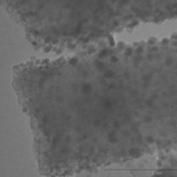Lithium-ion batteries have become the rechargeable energy storage system of choice for portable electronic devices due to their high energy density and specific energy capacity compared to other commercial battery technologies. They have enabled important development possible especially in portable consumer electronics such as smart phones, laptop computers since their first use in 1991. However, even the best batteries available provide insufficient energy density and durability for emerging electric transportation systems, including hybrid and fully electric vehicles (EVs). One way to address the capacity and cycle requirement of batteries for EVs is to pursue the development of new electrode materials.
Commercial lithium-ion batteries use graphite as anode material, which has a theoretical specific capacity of only 372 mAh g-1. Lithium (Li) reacts with graphite via intercalation mechanism, which is the insertion/extraction of Li ions in interstitial sites of the host lattice. In contrast, anode materials such as Si, Ge and Sn, which react with Li via alloying/de-alloying mechanism, show much higher specific capacities because they can host much higher concentrations of Li compared to graphite. However, the bonds between host atoms break during the alloying with Li, causing drastic structural changes. Although the theoretical specific capacities of these alloying anodes are very high (Si, 4200 mAh g-1; Ge, 1623 mAh g-1; Sn, 994 mAh g-1), they suffer from a rapid decay of the specific capacity and loss of electrical connection with cycling due to the dramatic volume changes, which induces mechanical stress and pulverization of anode material.
In order to overcome these problems, the advantage of these alloying anode materials’ high capacity is combined with carbon’s high electrical conductivity and mechanical strength.
Production of Si Decorated CNF Composite Structures
A number of nanostructured Si electrodes have been demonstrated for enhanced cycle lives; however, most of them have limited scalability because of the expensive and complicated experimental conditions used in the generation of Si nanostructures.
In this project, CNF/Si nanostructures will be produced using affordable and easy-to-disperse Si precursors, instead of expensive and hard-to-disperse commercial Si nanoparticles. For this purpose, first electrospun nanofibers of novel silane copolymers and polymer nanofibers containing Si precursor will be produced. CNF/Si nanocomposites with homogenously dispersed Si nanoparticles will be produced in a single step reaction with high pressure.
The study is supported by TÜBİTAK under the 3501 – Career Development Program (PI: Serap Hayat Soytaş).
Development of CNF based Anode Materials
CNF/Sn nanocomposite anode materials are produced via cost-effective electrospinning method followed by a carbonization process. In this way, it is possible to obtain ultrafine Sn at the atomic scale embedded in the conductive CNFs as well as Sn nanoparticles dispersed on the surface of the conductive CNFs. It has been demonstrated that the size and distribution of nanoparticles and the size, structure and conductivity of the CNFs can be controlled by the alteration of several experimental conditions. Therefore; desirable nanocomposite design can be obtained for best battery performance.
These CNF/Sn nanocomposites are able to accommodate larger strains than bulk Sn, thus reduce the extent of pulverization and provide good electrical contact resulting in higher capacities with longer cycle life.
The study is supported by TÜBİTAK under the 2218 – Postdoctoral Fellowship Program (PI: Serap Hayat Soytaş).
Development of Nanostructured Anode Materials
This study is an extension of the previous work to develop high capacity anode materials for lithium-ion batteries with long cycle life to be used in the electric vehicles. CNF/CNT/Sn nanocomposite anode materials will be produced in larger scale. The addition of CNTs will enable to use these anode materials without any binder or conductive additive by increasing its electrical conductivity.
The production of the nanocomposite anode materials will be extended to the pilot scale and finally to the full production scale. Finally, successful pouch cells will be used to construct a full battery module for EVs in cooperation with TÜBİTAK MAM and industrial partners.
The study is accepted for support by TÜBİTAK under the 1007 – KAMAG Program (PI: Serkan Ünal).



